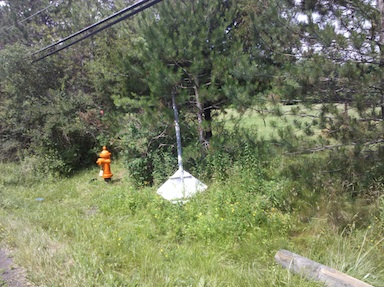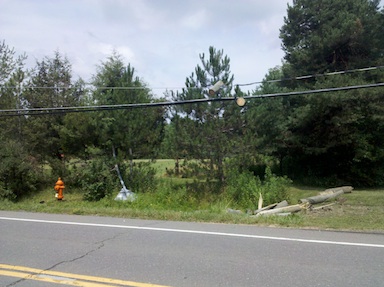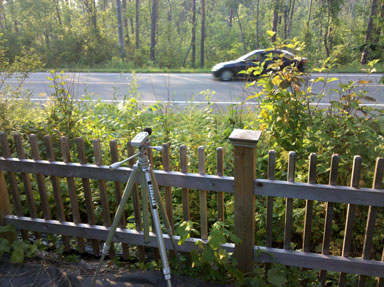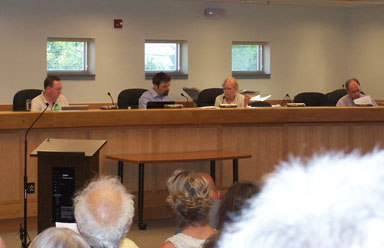July 1, 2011
Heroin arrest in Dryden
And from a storage locker on 366 somewhere... The Ithaca Independent has the story:
638 envelopes of heroin worth $15,950... The arrest of Daniel and Lorraine Pierce were made after Ithaca Police searched an East Buffalo Street apartment and a Route 366 storage facility in the Town of Dryden at 11:51 am, police say. Police also seized $2,980 in cash and a vehicle, according to WSYR-TV.
The Journal has a very similar story.
Gas lease map revisited
If your first response to the news that the state will be allowing hydrofracking around here is "what does this mean for me?", you're not at all alone. Between the patchwork parcel-by-parcel of gas leasing and the state's compulsory integration rules that encourage drilling where there are concentrations of leases, it's hard to forecast how this will go.
However, there is some information available, thanks to the Marcellus Accountability Project, which dredged through lease information a few years ago. Wading through that much information and tabulating it into maps is itself a heroic project, one I can barely imagine taking on. Their underlying map doesn't appear to have been updated much, or updated at all since February 2010, update and I've heard of some imperfections. However, it should give you a rough idea of the leasing situation.
[The rest of this is a reprint of Gas lease map, from August 2009.]
Talk about gas drilling is often pretty abstract. Signing a lease doesn't put a sign on the land saying "this land leased for gas drilling", and figuring out what has been leased can mean a long trip through stacks of deeds.
Today, though, you can take a look at what's been leased in Tompkins County, thanks to a new gas lease map from the Marcellus Accountability Project. The data was collected by hand, and there may have been changes over time. They do provide information if you want to go looking for more yourself.
In my immediate neighborhood, just west of the Route 13/366 overlap, there isn't very much leased, except The Orchid Place and Autoworks. (White is unleased. Dark brown means surface rights are included in the lease.) Down the road in Varna, Hillside Acres is leased.
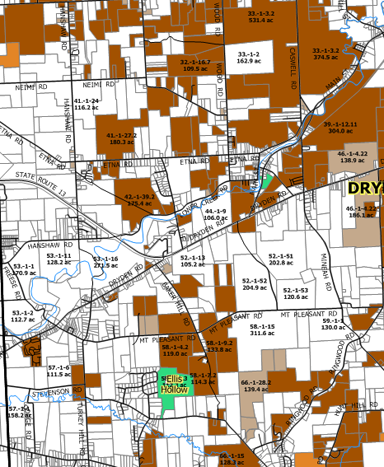
Gas leases along Routes 13 and 366 (approximately).
I worry that that map may understate the leases around the Route 13/366 overlap, as Angelika was looking for possible orchard land in some parcels marked "unleased" there - but the owner made clear that he'd sold rights.
The area around the Villages of Dryden and Freeville is pretty heavily leased:
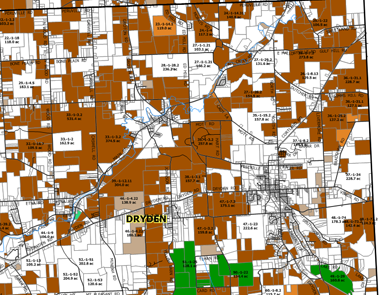
Gas leases around the Villages of Dryden and Freeville (approximately).
The southeastern hills are a mix of leased land and green state forest, making the state's decisions about its property seem extra-important.
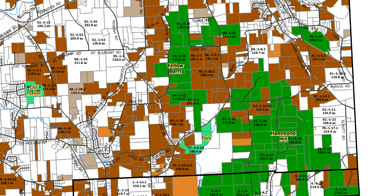
Gas leases in the southeastern corner of the Town of Dryden (approximately).
Another sign making it a lot less abstract is a field services company "setting up a $30 million outpost" down the road in Horseheads.
What Dryden will look like...
if hydrofracking comes.
I'm guessing interest in this will be strong, as it already came up in comments this morning!
Tuesday, July 12th
7:00-8:45
Dryden VFW
2272 Dryden Road (Rt. 13)Presenters from the Tompkins County Council of Governments Task Force on Gas Drilling:
Darby Kiley - Tompkins County Planner
Art Peace - Task Force Member
Looking Down From Above: What Gas Drilling Sites Might Look Like in the Town of Dryden
How many gas wells could there be and where could they be placed?
This informational "Mapping Project" is a result of planning done by the Tompkins County Council of Governments and is presented for the purpose of getting current information to Dryden residents.
See aerial views of landscapes in states where drilling is active.
Envision where well pads might go in Tompkins County and the Town of Dryden given 40 acre drilling units versus 640 acre units.
Referring to currently proposed NYS DEC regulations, see well placement possibilities as they relate to houses, streams, steep slopes and schools.
Understand how access roads and pipelines affect the landscape.
This looks to me like it focuses on what will happen if hydrofracking comes rather than what might happen (spills, etc.), which is a key piece of the story I don't think gets told often enough.
So what changed?
At first glance, the DEC press release on the state's decision to allow hydrofracking didn't look very encouraging. A lot of it requires trusting the DEC to be an effective regulator - "DEC enforcement and oversight of high-volume fracturing will be rigorous and effective" - which has been less and less of a good idea over the last few years, including in Dryden.
However, there are some pieces worth noting beyond those promises. These are the pieces I think most clearly affect Dryden, especially with regard to the existence and placement of wells.
Local Land Use & Zoning: Applicant must certify that a proposed activity is consistent with local land use and zoning laws. Failure to certify or a challenge by a locality would trigger additional DEC review before a permit could be issued.
I'll definitely want to see the final language on this. Could that DEC review decide to ignore zoning? Will the types of zoning be limited? On the surface, however, this looks like it would clearly make the ban Dryden will consider July 20th that much more important and clearly legal. (The state may have landed at this compromise.) Update: No, it's definitely clearly fuzzy.
Drilling Banned Within All Primary Aquifers and on State-Owned Land Including State Forest and Wildlife Management Areas
According to DEC maps, the nearest "Primary Aquifer" is in Cortland County, though Dryden does (I think from this) have a less-tightly-regulated principal aquifer, the Virgil Creek aquifer.
When I first read that bullet, I thought Yellow Barn and Hammond Hill State Forests would be off-limits to drilling, but then I saw this:
Surface drilling would be prohibited on state-owned land including parks, forest areas and wildlife management areas;
Clarifying it to surface drilling means that it has much less effect, especially for our pretty chopped-up state forests.

Approximate gas leases in the southeastern corner of the Town of Dryden.
Well water protection and other water protection: No permits would be issued for sites within 500 feet of a private water well or domestic use spring. No permits may be issued for a proposed site within 2,000 feet of a public drinking water supply well or reservoir at least until three years of experience elsewhere have been evaluated. No permits will be issued for well pads sited within a 100-year floodplain.
It will be interesting to see how this one plays out. I don't think wells are as commonly marked on maps as, say, buildings, so I'm guessing there will be a lot of surveyors out for this one. It does seem likely to keep drilling out of (or on the edge of) developed rural neighborhoods - with a possible odd exception for places with public water where few wells are still in use.
(I'm also curious what qualifies as a public well. I think mobile home park water supplies would count for that, for example - but I'm not sure.)
Those are just initial interpretations of something that's a press release, not the final rules. These are the bits that struck me as most interesting - by all means, read the DEC press release for yourself!
Update: Also making a big difference - Cornell will continue to ban fracking on its land. They own a pretty big chunk of Dryden, especially on top of Mount Pleasant.
Fireworks
No, not politics. The pretty exploding in the sky kind of fun.
Here's the latest from the Journal on tonight's fireworks at TC3. Parking at 7:30pm, with the show at 9:45pm. Here's the site for the show, with a lot more details.
There's also a viewing party at the VFW.
Cathy Wakeman had noted the fireworks in her Dryden Town Talk, as well as the silver anniversary of Dryden Presbyterian Church pastor David Robinson and a benefit for the Tompkins County Sheriff's Department's new K-9 police dog, "ROCK".
July 2, 2011
Hydrofracking SGEIS released
The DEC released a draft SGEIS to the press last night, holding the actual public release until July 8th, but that seems to be have been kind of a silly idea. The Journal's posted the 736-page Preliminary Revised Draft Supplemental Generic Environmental Impact Statement On The Oil, Gas and Solution Mining Regulatory Program (8.8MB PDF). Fun holiday weekend reading.
A reaction article includes County Legislator Martha Robertson and Town Supervisor Mary Ann Sumner's thoughts on the SGEIS. The most Dryden-specific piece of that is:
Town of Dryden Supervisor Mary Ann Sumner said she is "very cautiously optimistic" about the changes to the proposed regulations.
However, she said, "I do not think we will drop any of our other efforts to protect the town."
The town is one of several in the county working on ordinances to ban or control the impact of drilling. Sumner said she hopes to also institute a fund to finance pre-drilling water well testing for homeowners.
The DEC commissioner thinks hydrofracking can be done safely, of course. They've also formed an advisory council, and an article wonders whether the report will make anyone happy. Even if doesn't, I'm not sure I'd call that failure a sign of a good result.
There's also an article on the fireworks last night at TC3.
July 5, 2011
A few more notes on hydrofracking
The Ithaca Independent takes a look at revisions to the county's proposed road-protection law, which has been made easier on haulers, and now includes options for companies to pay for road damage instead of going through the permit process. The Ithaca Journal also reports.
Solid Shale, meanwhile, reports that the DEC may have added a question about local zoning to the drilling permit process, but that still pretty much leaves the question of local bans through zoning to the courts.
The Ithaca Journal asked over the weekend whether the SGEIS could appease anyone in this conversation, and the answer seems to be yes:
"The gas companies have been waiting for a positive signal," Diffendorf said. "This is it."
Update: Of course, that couldn't be the right answer. The gas companies are now making clear that it's not wonderful enough for them either.
July 7, 2011
Hedgehogs coming to Etna Saturday
I didn't expect this ad when I opened Tompkins Weekly last night:
Eastern States Hedgehog Show
@ Etna Fire Department
Wood Road, Freeville, NYJuly 9th, 20111, 9am-5pm
Public Welcome & Encouraged!!!
The Hedgehog Welfare Society would like to invite you to join us for the Annual Eastern States Hedgehog Show. Come learn about hedgehogs and see a few up close and personal!
It's $5 for ages 12 and up, $3 for children 5-12, and free for kids under 5. My favorite line in the ad is this:
Hedgehogs are welcome to attend and participate day of show, but pre-registration would be greatly appreciated.
Here's a brief description of a 2009 show. Sungiva likes the hedgehogs in her books, so I may just have to take her.
Still no answers in Etna arson
It's been almost a year since a fire destroyed Ithaca Police Sergeant Bryan Bangs' Etna home, but there's no news yet on who might have done it:
"We are still actively investigating the Bangs arson case. It is still open. Because of that, I wouldn't be able to discuss any leads," said Captain James Barnes of the New York State Police Bureau of Investigations, Troop C....
"There's still an active reward of $20,000 for anyone (who) provides information that leads to the arrest of the persons responsible," Ithaca Police Department Chief Edward Vallely said.
The Journal also has a deeply unsurprising headline this morning: DEC: Local hydrofracking bans could end up in court. I suspect that in the long run, Albany will find a way to this compromise to shift the battles away from Albany, but the outlook is presently fuzzy.
This utility pole lost
Or maybe it won, since the wires are still up, and I didn't notice a break in service. I'm not sure what happened to this utility pole along Route 366 in the 1100 block of Dryden Road. Anyone know?
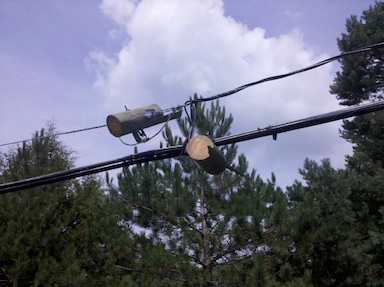
Remaining chunks of utility pole hang on wires.
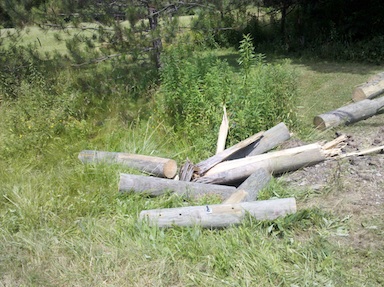
Utility pole, damaged and chopped.
I'm thinking it had to be something pretty big, but I was on my way to another appointment and didn't look at the damage to the pole that closely.
July 8, 2011
Might Auburn decision reduce Dryden truck traffic?
For now, anyway?
I was doing some editing Wednesday morning in the Dryden Community Center Cafe, sitting at the table that pretty much points into the four corners intersection. At one point I looked up and saw a convoy of Barber & DeLine water trucks going by, the first of which was labeled "brine wastewater".
Now I can't be sure, as I didn't see where the trucks originated and I didn't race to my car to follow them to their destination, but it seems at least reasonably possible that those trucks were carrying fracking wastewater to Auburn, where the wastewater treatment plant has been accepting it.
Auburn won't be accepting it any longer. By a 3-1 vote last night, City Council voted not to take those loads, despite the money they were bringing in:
The city has been under public pressure from the Cayuga Anti-Fracking Alliance to enact the ban. Several group members, including Beth Beer Cuddy, of Auburn, spoke before the vote. Afterward Cuddy said she was pleased with the outcome.
"I think it sends a strong message that Auburn is not going to be a dumping ground for the natural gas industry,'' she said.
The ban leaves the city with a big budget hole to fill. Auburn projected to receive $600,000 over the next year by accepting the waste at its wastewater treatment plant. However, several of those companies stopped dumping their waste when Cuddy's group started protesting several weeks ago.
Opponents say the wastewater contains high concentrations of salt and cancer-causing petroleum and radioactive agents and that the city's treatment plant is not equipped to remove those products before discharging them into the Owasco River. The stream drains into the Seneca River, which empties into Lake Ontario.
Like I said, I can't be sure that's where those trucks were headed, but it really brought home how many connections we're suddenly going to notice if fracking takes off in the area.
While at the Cafe, I also saw part of an old airplane body go by, which I'm guessing was for the amazing Tommy Come Home project, running on Southword Road.
July 9, 2011
Hedgehogs in Etna
If it's still Saturday before around 4:00pm and you're reading this, definitely visit the Etna Fire Station to see the Eastern States Hedgehog Show. (Admission is $5 for adults, $3 for kids 5-12, and free for kids below 5.)

A more cautious hedgehog curled in a ball.
We were there when it was fairly quiet, opening and getting ready for a talk by Cornell Vet School professor Dr. James Morrisey about hedgehog diseases. They'll be having judging from 1:30-3:30pm. At 3:45pm there's "bomber bowling" - maybe hedgehogs in exercise balls? - and from 4:30-5:00pm there's a hedgehog costume contest.
Can't make it? I've also posted a gallery of more of the show.
July 11, 2011
Honoring veterans with highway signs
Back in 2009, New York State designated Route 38 the Vietnam Veterans Memorial Highway of Valor, with signs at the ends in Owego and Sterling. At a tribute ride that October, I asked Village of Dryden Mayor Randy Sterling whether he thought that some local signs might be a good idea. He sounded like he was already on it, and recently I noticed that Dryden now had signs at its Route 38 entrances.
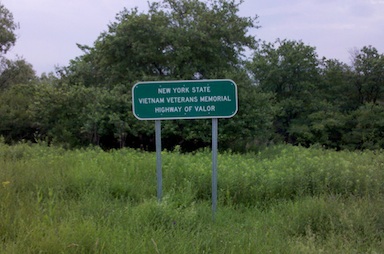
Sign for the New York State Vietnam Veterans Memorial Highway of Valor along Route 38 across from Dryden High School.
The Village of Groton also has signs.
July 12, 2011
Tonight: what drilling might look like in Dryden
Repeating an older announcement:
Tuesday, July 12th
7:00-8:45
Dryden VFW
2272 Dryden Road (Rt. 13)Presenters from the Tompkins County Council of Governments Task Force on Gas Drilling:
Darby Kiley - Tompkins County Planner
Art Peace - Task Force Member
Looking Down From Above: What Gas Drilling Sites Might Look Like in the Town of Dryden
How many gas wells could there be and where could they be placed?
This informational "Mapping Project" is a result of planning done by the Tompkins County Council of Governments and is presented for the purpose of getting current information to Dryden residents.
See aerial views of landscapes in states where drilling is active.
Envision where well pads might go in Tompkins County and the Town of Dryden given 40 acre drilling units versus 640 acre units.
Referring to currently proposed NYS DEC regulations, see well placement possibilities as they relate to houses, streams, steep slopes and schools.
Understand how access roads and pipelines affect the landscape.
This looks to me like it focuses on what will happen if hydrofracking comes rather than what might happen (spills, etc.), which is a key piece of the story I don't think gets told often enough.
July 13, 2011
3rd Annual Highway of Valor Tribute Ride
I guess those signs went up at the right time. Thanks to Kathy Elliott for forwarding me this announcement:
Vietnam Veterans Memorial Highway of Valor Tribute Ride - 3rd Annual July 16, 2011
Owego, New York (NY)
New York State Route 38 is now designated as, " Vietnam Veterans Memorial Highway of Valor." To draw attention to the new name of the highway and to honor Vietnam Veterans, Chapters 377, 480, and 704 of Vietnam Veterans of America and Chapter 17 of The Blue Knights are sponsoring the 3rd Annual Tribute Ride. The ride will begin at 10Am on Saturday July 16, 2011 at Marvin Park, Owego,NY. There will be a stop in Groton,NY for gas and food then the ride will continue north to Fair Haven where the 98 mile ride will end, and once again be food and other refreshments. The ride is open to the public. Register before 9:30AM the day of the ride.
Want to join? More details here.
Blogging without broadband
Tonight's Town Board Agenda meeting was pretty useful, but one piece made me especially happy - if happy in kind of a frustrating way. I met another Dryden blogger, Claire Perez, of It's About the Story.
She was there because of the seemingly infinite frustration of trying to get broadband connections from Time-Warner Cable. Town Board member Jason Leifer pointed out tonight that even though Time-Warner has talked about bringing service anywhere with 20 customers along a linear mile, the latest franchise contract they presented doesn't say anything like that. Instead, it points to Public Service Commission language that ends up at more like 35 per mile.
Her broadband posts explain all too well the strange world of our information infrastructure. I especially liked the game of Mother, May I? she plays with the question of broadband.
Perez asked if the Town Board could hold a public hearing on broadband issues. While Leifer joked that Time-Warner had included a public hearing notice on their proposed franchise contract, the Board had little interest in the basically nothing the company was offering. Supervisor Mary Ann Sumner noted that the Tompkins County Council of Governments was discussing having a group of municipalities negotiate as a consortium, and she and Leifer thought a public meeting on the subject might be a good idea in September.
The board also discussed public hearings needed for a special use permit and fee waiver for the wireless broadband Clarity Connect projects they approved in March. That seems to be moving toward construction, if slowly.
July 16, 2011
Lamenting a lease
I've heard lots of people regret leases they signed, though usually in a landlord-tenant situation. This morning's Ithaca Journal looks at a harder (and likely longer-lasting) regret: people who signed gas leases before realizing how hydrofracking might drastically increase the impact of those leases on their land and lives.
Junior Fire Academy in Dryden
I should probably set up an automatic story to point to Cathy Wakeman's always excellent and generally impossible to summarize Dryden Town Talk articles in the Ithaca Journal. This week's installment looks at Junior Fire Academy, Covenant Love Community School's open house, the Etna Community Church, and Music in the Park.
Where might drilling happen?
I didn't manage to get to it, but the the Tompkins County Council of Governments Task Force on Gas Drilling presented "Looking Down From Above: What Gas Drilling Sites Might Look Like in the Town of Dryden" on Tuesday. Fortunately, the slides are available, so I'll be basing a few entries on the slides.
All of this looks at how gas drilling might happen, if in the end, it's allowed. The public hearing for the proposed Dryden ban is this Wednesday, July 20th, at 7:00pm at the Dryden Town Hall.
The presentation started with an introduction to gas drilling, discussion of Pennsylvania experience, and a general discussion of the maximum number of possible drilling pads spaced evenly across the landscape. Dryden could have 93 drill pads (of 8-12 wells each at 640 acre spacing) on that model - but that only establishes a maximum unlikely to be reached. The more likely reality for Dryden, based on leases, the way they cluster, and New York State's compulsory integration laws, is more like 44.
(That's assuming the lease map is correct - it may have changed since it was created or have other imperfections.)
I'll tell the story a little differently, focusing on their forecasts of where drilling pads might go and the impacts on the area. The key maps I suspect Dryden readers will want to see are on pages 24 and 26 of their part B, which I've pulled out as DrydenN.pdf (270KB PDF) and DrydenS.pdf (274KB PDF).
For folks on the edges of the town, I've also broken out Caroline (North) (393KB PDF), Groton (385KB PDF), Lansing (North) (426KB PDF), and Lansing (South) (426KB PDF).
I'm going to focus on two locations: one, selfishly, an isolated site on the hillside above my house, and the other a circle of sites around the Village of Freeville. I know the terrain and traffic patterns here, while the Freeville story can look at a network of sites around a small populated place.
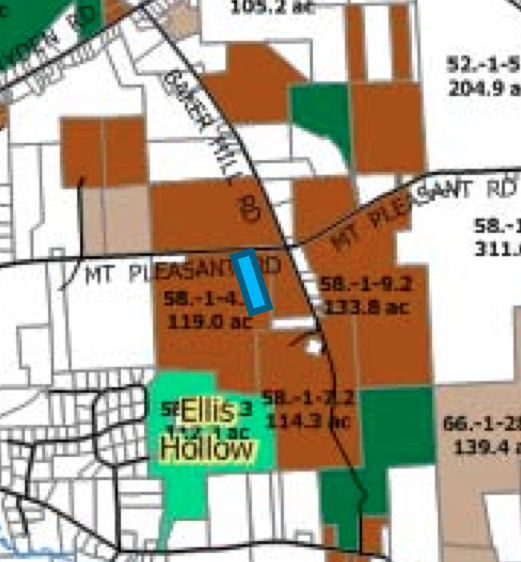
Possible well pad on the hillside above my house. (Note that Baker Hill Road doesn't go through between Mount Pleasant and Eliis Hollow Creek roads.)
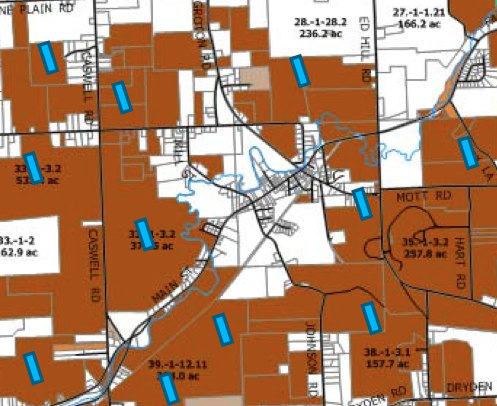
Possible well pads around the Village of Freeville.
Those markers aren't physically to scale - the impact of each well pad affects about 8.8 acres. However, I suspect that as the story emerges, those markers will feel too small. They also aren't placed precisely where drilling will take place. The gas companies will survey the landscape to decide where they want the pads, retention pads, wells, gathering lines, and the rest might go.
There'll be more over the next few days here.
July 18, 2011
Information security issues at Dryden schools
This morning's Ithaca Journal report on an audit that found security issues in the Dryden Central School District, though it doesn't disclose what they are and the district is working to address them.
There will be a forum exploring the 1095 page (so far) draft SGEIS on hydrofracking. It will be at the Women's Community Building, 100 West Seneca Street, in Ithaca, with County Legislator Martha Robertson moderating the panel.
In academic news, the TC3 Dean's List is out, and there's a table on how schools did on New York State Regents exams. (I was good at taking those tests, though I'm not convinced they measure all that much.)
Finally, the Tompkins County economy seems to have shrunk a bit in May.
Land use by hydrofracking operations
When I was in high school, a friend of mine's family had a natural gas well across the road from their farmhouse. I drove by yesterday, and it's still there, a probably 30' by 20' space of pipes surrounded by hedges with some gates for vehicular access. It is, of course, a traditional well, and that was a lot of why I wasn't worried initially about the prospect of gas drilling coming to Dryden.
As I noted Saturday, though, the drilling model for the Marcellus shale uses approximately 8.8 acres per well pad, though each of those pads will probably support 8-12 wells. Where does that land go?
The TCCOG presentation slides' Part B (7.8MB PDF) describe an average area per well on page 9:
Western PA Aerial photo studies show average of 8.8 acres per site: 3.1 acre pad, 5.7 acres access road, impoundment.
The pad itself is the hub of activity, but getting lots and lots of heavy equipment there means building roads, and the volume of water involved means digging and lining water impoundment pools. Those can be several acres just by themselves, and they aren't swimming pools - they're stoutly defended by fencing, as is all of this, to keep visitors out.
8.8 acres is a good chunk of land, but admittedly it's only 1.375% of the area of a 640 acre drilling unit, and, at least in theory, will be restored to its original configuration when all of this is done.
There are a few extra issues here. The pieces aren't necessarily one neat chunk of land. Impoundments are usually set off from the drilling pads, and the length of the roads is largely determined by the landscape.
Seismic studies?
I know that the gas companies did seismic studies of the area in 2007. A landman even came to the Dryden Town Board to ask permission at some point and encourage the Town to think about leasing its land. (They didn't.)
Does anyone know - who can share them - what those studies found?
July 19, 2011
Would you like to live on 13 or 366?
You may, like me, already live on a busy road, with cars, dump trucks, concrete mixers, buses, and tractor trailers going by. Or, you may live on one of Dryden's many peaceful roads, with only the occasional vehicle passing, or something in between.
If hydrofracking comes to Dryden, the noise distribution is going to change drastically. Many people who thought they lived in the middle of nowhere are going to have to deal with loud trucks passing their house for years.
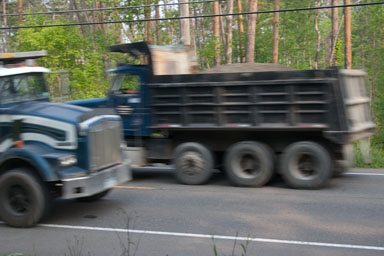
Gravel trucks passing on Route 366.
There was a while last month, I think at the peak of the Mount Varna filling, when trucks went by in a constant cycle from that parcel to RMS Gravel and Stinky's. Sometimes it was a truck every five minutes, sometimes it was a series of three going by at once. The road was suddenly a lot louder even than usual, substantially more noticeable inside my house (about 90 feet from the road.)
According to TCCOG's slides, part B (7.8MB PDF), page 12, The New York City Department of Environmental Protection estimates 1200 truck trips per well, while New York State suggests a range of 900 to 1300 trips. I suspect that terrain and the amount of fill needed to build a stable pad and supporting infrastructure is a lot of it, but the potential for repeated fracking to extend the life of the well also creates possible later bursts.
Each pad can have 8 to 12 wells, and I believe the state is limiting the rate of drilling to four wells per pad per year. That's a lot of trucks on their way to and from the pad, with a lot of reverse beepers at the pad, most likely.
This isn't your ordinary traffic, either. I've been experimenting with a decibel meter in front of my house, measuring sound levels at about 30 feet from the road.
The highest reading I've seen the meter record is 89.4 dB, a concrete truck passing loudly. Truck brakes can be much louder - fortunately I live on a straight stretch, and haven't had the meter out for one of those episodes. Today's peak was 87.4 dB.
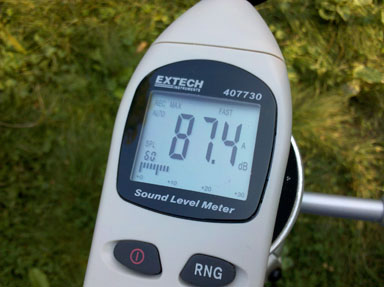
Today's peak: 87.4 decibels. (The low was happily unmeasurable, below 40 dB.)
Cars range from about 60-80 decibels, mostly depending on the state of their muffler and tires. Motorcycles range from about 50 to the low 80s, depending on how excited the owner is about loud pipes. Ordinary tractor trailers have been around 75-80, as are most buses. Above 80, it's pretty much always gravel trucks or concrete trucks. (An airplane flying low right over the house might manage these levels too, but they're usually around 75-80.)
Remember, the difference between 70 and 80 decibels isn't 14% louder - it's ten times louder. Every step of 10 decibels represents a multiplication by 10.
These noise levels aren't fun. It's extremely difficult to enjoy a front yard, at least with anyone you want to talk with, while this kind of traffic is passing, and even the back yard is difficult. Inside the house is okay, so long as I keep windows and doors that face the road closed. Cars passing at night, I'll admit, do help me go to sleep sometimes.
Let's take that loud and look at how it'll apply to the wells around Freeville.

Possible well pads around the Village of Freeville.
Freeville already has a fair amount of heavy truck traffic because of RMS Gravel being just outside, and two of these pads aren't that far from RMS. (The Mott Road/366 intersection may get complicated, though.) That might at least reduce some truck traffic, though water, chemical, and other trucks will still have to come through. The Cady Lane well shouldn't have too many neighbors, but areas along 366 and Johnson Road will see a lot more truck traffic. West Dryden and (a fairly empty stretch of) Caswell Roads will be busy. The pad to the north of the village might make Brooklyn Road very busy, or that traffic might stay on Ed Hill Road, depending on where construction happens.
The traffic impact of drilling on the hillside above my house seems likely to be focused on Baker Hill Road and the short stretch of 366 connecting that to Route 13. Mount Pleasant Road might also see traffic, but has the same grades as Baker Hill Road combined with its own intersections, curves, and roller coaster sections.

Possible well pad on the hillside above my house. (Note that Baker Hill Road doesn't actually connect Mount Pleasant and Eliis Hollow Creek roads.)
My bet, looking at the full map of the south of Dryden (274KB PDF), is that I won't personally have to deal with vastly more traffic than I already have. The few pads to my east are much further south, bringing these issues to residents of Snyder Hill Road and Route 79. It is, of course, possible for trucks to come up from Ithaca on Routes 79 and 366, but it's hard to imagine why truck drivers would want to do that. I suspect that those who do will be lost in the already substantial barrage of trucks carrying gravel and concrete to Ithaca for more traditional construction projects.
Even if you live on a state highway, though, you may want to take a look at the map (full map of the north of Dryden (270KB PDF) or full map of the south of Dryden (274KB PDF)) to get a sense of just how much noise and diesel exhaust is likely to be coming your way should fracking come to Dryden.
Update: This leaked transportation impact document brings some of this home as well, though more on a "what happens to my taxes?" level than a "what happens at my house?" level.
New pro-drilling site
The Dryden Safe Energy Coalition has put up a site, as well as a slightly broken ad in The Shopper.
It doesn't seem to have anyone claiming credit for posting it, but it does have the same domain registration information as the Dryden Republicans site.
Public hearing Wednesday night on fracking ban
I suspect it'll be busy. You can see the proposed amendment to the current zoning law on the Town's Gas Drilling Information page.
7:00pm, July 20, 2011, at Dryden Town Hall, 93 East Main Street/Route 392 in the Village of Dryden.
July 20, 2011
Speculations
The Dryden Safe Energy Coalition has a page claiming that Dryden would be "confiscating" $175 million if a natural gas drilling ban is passed.
How do they calculate that? Did they get ahold of the seismic studies and calculate what the price of gas is likely to be?
No. They grabbed an easy statistic, the number of acres in the Town - 60,288. Then they multiply by another big number, $3000/acre, the most recent high number gas companies are offering as signing bonuses. That would bring them to $180 million, but they're cautious enough to limit it to property actually on the assessment roll and call it $175 million.
They don't mention compulsory integration, New York State's policy in which having 50% of a drilling unit leased establishes rights to the other 50% - without that signing bonus. They don't mention that the 41% of Dryden land that's already leased has already received that bonus - and generally at levels far far lower than $3000/acre.
They even screw up and claim that:
Dryden residents have considered energy development. 41% of Dryden landowners have leased their land.
41% of Dryden land is leased, but they give no statistics on how many parcels are leased or how many people actually did that leasing. There's a pile of numbers about the size of lots and averages of this money spread across the Town, but none of it reflects the terms of actual leases held.
It is, of course, possible that the massive shortfall in the reality of that $175 million number could be made up by royalties over time, but mostly this looks like an exercise in "hey, look over here at this shiny thing!" rather than a calculation that means something.
If you want to look at a big shiny number, think about a billion. That's roughly the value of assessed property in Dryden these days. How much of a hit will that take if drilling comes to town?
Dog survives overdose
Dogs are notorious for getting into and eating yucky things. Combine that with someone throwing out a pile of what seems to have been marijuana gone bad, and you have a very unhappy dog:
"Usually we have a presumed diagnosis of marijuana toxicity, but with Lily, we had much more support," he said. The material in Lily's blood and stomach both tested positive for THC.
I knew methampehtamine labs left environmental disasters in their wake, but didn't know this was possible.
July 21, 2011
"Preserves far more property rights than it takes"
These were my comments at last night's public hearing, though I dropped the italicized sentence for time.
There's been a lot of talk lately about "confiscating property rights" with a ban on gas drilling. That discussion seems to focus on one small sliver of "property rights", the right to extract as much money as you can from a place, at the expense of everything else.
If hydrofracking is allowed in Dryden there will be wholesale confiscation of property rights. Some of it will be formal, through compulsory integration, in which the state can force citizens to hand over their mineral rights to private interests. If you oppose eminent domain for private benefit, you really should take a look at compulsory integration.
Spreading industrial work sites throughout the Town, and connecting them with barrages of heavy trucks, is also going to confiscate a lot of property rights. Air pollution from those trucks and the rest of the equipment will make the countryside feel strangely urban. It may be difficult to transfer the peace and quiet of someone's yard and house, but there's a reason that "quiet enjoyment" is a legal term.
Those are just the problems that are 100% certain to come with hydrofracking. The environmental risks are real and demonstrated regularly. It's a gamble, one we all hope we win, but watching and waiting to see if your well water is going to remain drinkable isn't exactly a comfortable exercise of property rights.
I ask the board to pass the proposed ban on gas drilling. It preserves far more property rights than it takes.
Now that was a PUBLIC hearing
I'm not sure how many people came. The parking lot was full at 6:45, and the room was overflowing, with lots of people in the hallway. I stood in a corner that didn't make for great pictures, but you can see a little of the density here:
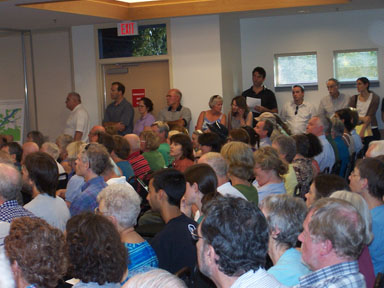
Crowd at July 20th Town Board meeting.
My probably imperfect notes record 74 speakers, with about a 3-1 split in favor of the ban. I think nearly everyone was from Dryden, with the notable exceptions of a lawyer from Fabius and a geologist from Cayuga County who were there to speak against the ban. Speakers mostly did well at keeping it short, and I was impressed by the efforts people made to avoid simply repeating each other.
Given the intensity of debate and the huge number of people in the room, I thought the crowd behaved pretty well, keeping applause brief and understanding the board's need to keep comments short. Yes, there were some cranky comments, sighs, and coughs from the audience. It wasn't a church service, but it was generally impressive.
It may be the first board meeting where I've seen substantial numbers of people under 25. A 19-year-old and a 21-year-old spoke, and there were younger kids there too. The age distribution was impressive, from the very young to the very old. Geographic distribution was impressive too - there seemed to be people there from nearly every corner of Dryden.
The board didn't vote on the fracking amendment last night - they have 60 days after the public hearing to do so. The next likely opportunity is at the extra meeting they scheduled for other hearings August 2nd.
I'll be getting and posting the Town's recording of the meeting soon.
Gas brine spread on region's roads
It's not clear to me that the brine referenced in this article is hazardous or coming from hydrofracking operations, but there is clearly some use of gas wastewater being spread on roads throughout the Southern Tier. I tracked through the map and saw a marker for brine spreading in Dryden, which prompted me to download the 273 page PDF (29.5MB) of permits. It's not the Town - page 146 lists Beck Farms as using brine from the TEPPCO facility in Harford, and pages 166-8 and 203 have more details. (The Harford Highway Department is also using it.)
Update: missed a sidebar. The state is also buying brine from TEPPCO for use in de-icing on "Routes 13, 34B, 38, 79, 89, 96, and 96B".
An update on the county legislative redistricting process included this tidbit:
The City of Ithaca's Fall Creek neighborhood showed significant population loss, with the greatest increases in the Town of Dryden and on West Hill in the Town of Ithaca.
I really need to spend some more time with the census data.
Where to send comments
It sounded last night like comments on the proposed hydrofracking ban have been going to a lot of different places beyond the public hearing last night, so I asked this morning what the best place to send comments is.
The most reliable place to send them, to ensure that they reach the entire board, is the Town Clerk, Bambi Avery, townclerk@dryden.ny.us.
Neimi Road closing Monday-Wednesday
I probably should have noted this closing earlier, but the Tompkins County Highway Department will be closing Neimi Road between Sheldon and Hanshaw Roads for pipe replacements next week. Hopefully repaving is coming eventually too.
July 22, 2011
Journal reports on fracking ban hearing
The Journal has a piece on Wednesday night's public hearing. There's one bit I'd correct:
The town board has 60 days to consider comments before bringing the ban to a vote, but Supervisor Mary Ann Sumner said the board would vote on the proposal a bit early, at the Aug. 2 meeting, 7 p.m. at town hall.
"A bit early" makes it sound like the board is supposed to wait 60 days. That's not accurate. The board is obligated to vote within 60 days, and often votes on issues the same day as the public hearing.
East Hill Plaza P&C to become P&C Fresh
I'm not sure how I missed this, but someone left a July 6th Syracuse Post-Standard in the waiting room at Guthrie, and it had a story on the East Hill Plaza P&C being sold.
When Tops bought P&C out of bankruptcy, they had seven stores that had to operate separately, with an eye toward them being sold eventually. This deal puts three of those stores, in Ithaca, Sayre, and Cortland, into the hands of former employees of Penn Traffic, P&lC's old owner.
It doesn't, however, include the Triphammer Cayuga Mall P&C.
(And no, East Hill Plaza isn't in Dryden, but it's just outside - and I run into plenty of Dryden residents there.)
July 27, 2011
Etna Post Office survives?
I'm not sure this really means that we don't have to worry about the Etna Post Office closing, but at least they're not on the Expanded Access Study List of possible closures.
Public hearing on hydrofracking ban
I don't think I've ever seen a public hearing in Dryden go three hours. I got the audio recording from the town (185.6MB QuickTime .mov file), and here's an index of speakers:
Peter Davies - 1:28
Vicki Myers-Wallen - 3:00
Jim Crawford - 5:17
Dave Mackenzie - 8:36
Art Berkey - 12:31
Henry Kramer - 15:19
Jane Edwards - 17:47
Charles DeMotte - 19:05
Caren Cooper - 20:53
Deborah Cipolla-Dennis - 23:03
Joanne Cipolla-Dennis - 24:13
Nancy Morgan - 27:40
Ron Symanski - 30:00
Jack Bradbury - 32:32
Cliff Norte - 34:30
Buzz Lavine - 36:14
Jack Edmonds - 38:55
Ben Haith - 41:43
Joe Wilson - 44:00
Judy Pierpont - 45:42
Craig Schutt - 48:20
Doug Barton - 51:40
Simon St.Laurent - 53:45
Janet Shay - 55:20
Ernie Balch - 56:10
Marie McRae - 58:35
Robin Tropper-Herbel - 59:47
Martha Ferger - 1:01:57
Nancy Miller - 1:12:30
Paula Peter - 1:15:20
Tonya Engst - 1:18:50
Linda Lavine - 1:21:29
Peggy Walbridge - 1:24:48
Ron Applegate - 1:27:12
Evan Carpenter - 1:29:10
Dennis Mix - 1:32:05
Eric Liner - 1:35:00
Charles Geisler - 1:38:12
Bruno Schickel - 1:39:33
Gideon Stone - 1:44:50
Hilary Lambert - 1:46:28
Peter Quinn-Jacobs - 1:48:12
Charles Hatfield - 1:49:30
Russ Beck - 1:50:29
Julie Van Erden - 1:53:25
Kevin Mayer - 1:55:56
Martin Hatch - 1:58:28
John Burger - 2:01:32
Lance Salisbury - 2:04:56
Jennifer Savran Kelly - 2:09:12
Diane Kimmich - 2:11:01
Rick Ryan - 2:11:45
Lea Elleseff - 2:13:19
Michael Lane - 2:16:00
Martha Robertson - 2:18:20
Bernie Cornelius - 2:23:38
Bob Beck - 2:25:55
Will Parker - 2:28:05
Jack Ruckheim - 2:32:10
Jean Cotterill - 2:33:46
Janelle King - 2:36:35
Joel Osmeloski - 2:37:37
Mary Warfield - 2:39:50
Jason Dickinson - 2:42:33
Deborah McMillan - 2:43:52
Ken Schlather - 2:45:37
Barbara Apella - 2:47:35
Dan Burger - 2:48:44
Tom Rischel - 2:49:40
Amari Meader - 2:54:27
Danielle Lemaire - 2:57:18
Graham Dobson - 3:00:56
(Break) - 1:03
Mary Ann Sumner on why total ban - 1:51:52
Mary Ann Sumner on Syracuse / NYC watershed exemptions - 2:31:13
Ben Haith of Auburn and Julie Van Erden of Fabius, both of whom seemed to be speaking on behalf of the drilling industry, are (I think) the only non-Dryden residents in the list.
It is, of course, possible that I got a name wrong - please let me know if you find errors in the list!
July 28, 2011
Ernie Balch comes up on 100
Yesterday's Dryden Town Talk recognizes Ernie Balch's approaching 100th birthday. He's still busy, even speaking at a public hearing last week.
The article also notes this week's 4-H Youth Fair, running now at 4-H Acres on Lower Creek off Route 13, and the Dryden Lake Festival, which will be August 6th, and the upcoming Intergenerational Band and Chorus concert Saturday.
July 29, 2011
County exploring redistricting, gas drilling buildout
The Ithaca Independent has two stories about activity at the county level that Dryden residents may want to watch:
The first, Tompkins Politicos Debate Size of Future County Legislature, looks at the challenges of redistricting after the 2010 census. The key Dryden bits:
Legislator Michael Lane (D-Dryden) countered that shrinking the Legislature could reduce costs and alleviate cramped space. "We're all expendable," Lane noted.
Any redistricting plan should follow neighborhood line, many suggested. Legislature Chair Martha Robertson (D-Dryden) said planned changes could also follow school district boundaries. Any redistricting must not stray from the district's population by five percent, according to state law.
...At the other end of the spectrum, the Town of Dryden (represented by Lane and Robertson) have both benefitted from the population shift.
There's also Council Orders Study of Gas Drilling Impact on Local Residents. The Tompkins County Council of Governments will be spending $10,000 'from private foundations, individuals and other "local entities,"' and may decide to spend $2000 of its own money as well to create a study for Tompkins County similar to a study done for Middlefield, NY.
Gas industry PR notices Dryden ban discussion
Ever wonder what the gas industry thinks of Dryden's discussions of gas drilling? Wonder no more. Via One of Nine, you can see Energy in Depth's assault on the idea of a ban.
There's nothing particularly new there, though they did post a few chosen videos, and I guess this at least means they've noticed that not everyone in Dryden is a fan. If only I could bring myself to respond in the same condescending tone...
July 30, 2011
False "fair and balanced" comes to Dryden
The Ithaca Journal fell hook, line, and sinker for bizarre claims of rationality and balance from the Dryden Safe Energy Coalition.
Henry Kramer uses words like "unemotional facts", "dispassionately presented", and even "neutral" about the Dryden SEC without seeming to understand what those words mean. A quick glance at the Dryden SEC site and the industry-run Energy in Depth site makes it pretty clear that the DSEC lines up on the side of the gas industry and borrows its pretend objectivity. DSEC is the pro-fracking group, as its members made pretty clear at the public hearing.
Unfortunately the Journal let them present themselves as if they were the middle of the conversation. I'm concerned that the Journal didn't actually read the site. The very first blog entry states their position clearly in its title: "Extracting natural gas from shale is safe and economically sensible."
It only gets emotional from there.... This blog entry, for example, stops just short of "ANTI-AMERICAN" and certainly includes a dose of emotion. The next piece warns that Pennsylvania's prosperity might leave us behind, and it's pretty much an endless slog of similar echoes about how great gas drilling is, without links to anything that might make you think twice about why they're putting such effort into this story.
The article also includes the nonsensical $175 million claim.
It's perfectly fine to make these arguments, even when they're broken. I don't understand, however, how the Dryden SEC can pretend they're somehow above the fray, and I really can't imagine how the Ithaca Journal fell for it.
County budget discussion Monday night in Varna
Last year's edition of this was already a painful exercise in figuring out what the county is actually allowed by the state to cut, and it sounds like this year will be even darker. I'm sure the "slash government" crowd will be there to enjoy the shrinking, but a lot of the rest of us will be wondering how long the "optional" bits like sheriff's patrol, libraries, and youth services can survive.
Hello, neighbors - Please try to join us for this session, to hear about the county's budget and share your thoughts, early on in our process of creating the 2012 budget. We'll be talking about the choices that will affect you, your family, your neighbors, and our whole community. And please pass this message along to others! Thank you! - Martha
Community Meeting on the 2012 Tompkins County Budget
County Legislators Martha Robertson and Mike Lane
Monday, August 1, 2011, 7:00 P.M.
Varna Community Center
943 Dryden Road, VarnaLearn about the fiscal challenges Tompkins County faces as it prepares for 2012, and let officials know how you would like the County to respond.
The public is encouraged to attend.
July 31, 2011
P&C Fresh transition this week
I mentioned the transition from P&C to P&C Fresh coming to East Hill Plaza. It looks like it will be happening in just a few days:

P&C Fresh coming soon - closing Tuesday at 3, reopening Thursday morning.
(And no, I don't normally post on Sundays, but this seems important and immediate.)
